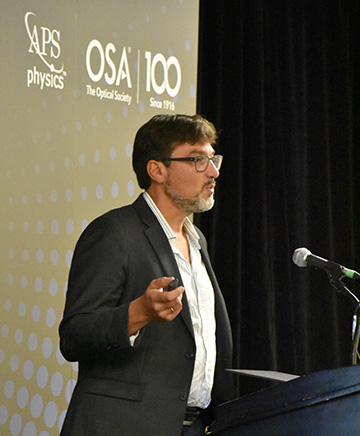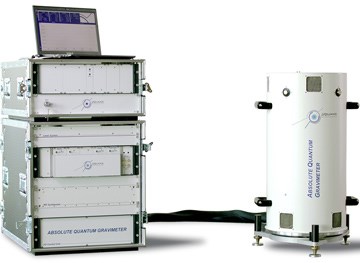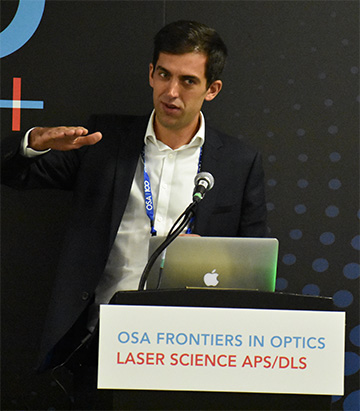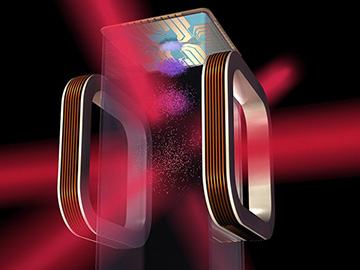
Philippe Bouyer, Institut d’Optique, at FiO+LS 2019.
The scientific program of the 2019 Frontiers in Optics+Laser Science meeting in Washington, D.C., got off to a strong start on Sunday, with a three-session package that offered a deep dive into the emerging world of quantum sensors.
Considered by many to be the low-hanging fruit in quantum technology, where practical applications will emerge soonest, quantum sensors have been the focus of intense work in recent years, with some commercial quantum gravimeters and accelerometers already coming on stream (see “Quantum Sensors: A Revolution in the Offing?,” OPN, September 2019). Sunday’s talks, from both academic and industry personnel, recounted some of that progress, both on Earth and in space. And they also suggested the opportunities, and challenges, on the road to a future of compact, field-ready quantum sensors.
From lab to industry—and back
One theme that emerged early in the symposium was the value of links between academia and industry in making that future happen. That came out particularly clearly in a presentation by Philippe Bouyer of the Institut d’Optique Graduate School/CNRS, France, who recounted the story of three technologies his team has worked on, and the journey of those technologies from academia to industry—and then back to academic lab.
In one case study—the use of matter-wave interferometers to create quantum gravimeters— Bouyer’s team faced the fundamental challenge of simplifying a dizzyingly complex array of components on a large optical table into a compact, field-ready commercial instrument. Much of that simplification, he noted, focused on the photonics side of the equation. In particular, the atom used for the interferometer, rubidium, has characteristics that allowed the team to take advantage of the well-developed industry supply chains for equipment operating at optical-telecom wavelengths.

An absolute quantum gravimeter from the French company Muquans, co-founded by Bouyer, uses laser beams to measure how cold atoms fall under gravity within a 70-cm-high white cylinder. [Image: Muquans]
“Thanks to that, we were able to build a commercial device,” Bouyer said. And indeed, such gravimeters are now being sold to a small number of research clients through a company that he co-founded, Muquans.
But advances in this arena also depend, Bouyer stressed, on flows of ideas from industry to academia—to identify research opportunities for new technologies. That kind of interaction is evident in a collaboration between his lab and the company iXblue to create a matter-wave-driven, non-GPS-dependent navigation scheme that works by continual recalibration from a known position, and for which a prototype has been developed.
And even work that seems driven by “pure science” can ultimately depend on industry for success. Those dependencies were highlighted in the third technology effort Bouyer reviewed, an approach to gravitational-wave detection that would rely on matter-wave interferometry—rather than optical interferometry, as at the celebrated Earth-based LIGO and Virgo facilities and the future space-based LISA.
Bouyer’s group is working on a prototype of such a device, which he suggests could pick up gravitational-wave events at a window of low frequency ranges not covered by the laser-based interferometers. And he says that the project would be effectively impossible without, again, the ability to tap the mature telecom-industry supply chains that his team has already taken advantage of for other matter-wave-based sensors.
Making sensors “truck-bed ready”
A different angle on quantum tech’s industry dimension came from another speaker, Gary Tarkenton of Lockheed-Martin, the world’s largest defense contractor. Tarkenton pointed out that Lockheed-Martin’s interest in quantum technology “goes back a long way,” with an early interest in quantum computing for code breaking and in oscillators for GPS applications. More recently, since around 2014, the company’s interest has shifted to sensing applications—particularly in remote sensing—in line with changes in the interests of its clients.
Lockheed-Martin’s niche in the quantum realm, Tarkenton observed, isn’t the basic research, but in making much of that research field-ready. While work in a controlled lab environment has some clear advantages—such labs are clean, thermally stable and vibration-controlled—actual field situations tend to be dusty and dirty, with wild temperature swings and platform vibrations. “Part of what we do at Lockheed-Martin,” Tarkenton said, “is take the designs and try to make them really robust, so that you can actually throw them in the bed of a truck, drive around and have them work.”
Matters of gravity

Joseph Thom of M Squared.
Whether on truck bed, shipboard or some other platform, much of the day’s discussion focused on applications in an area of quantum sensing that’s maturing rapidly: accelerometers and gravimeters that rely on atom interferometry. Joseph Thom of M Squared, Glasgow, U.K., reviewed some of the laser technology that his company has developed to enable such devices. He tagged the company’s Solstis titanium-sapphire laser in particular as “a nice platform for quantum experiments” based on its large tuning range, high power, narrow linewidth and low noise.
M Squared has leveraged this technology, Thom noted, in demonstration systems for compact matter-wave interferometers used in gravimetry, used in underground surveys; and in three-axis accelerometers, for potential GPS-free-navigation applications. In the latter work, undertaken with Imperial College London, the company has proceeded to some early trials onboard boats in a canal network in London (“part of my job this summertime,” Thom said).
Brenton Young of AOSense, Inc., based in Sunnyvale, Calif., USA, also looked at the possible applications of quantum sensors in navigational systems. Young stressed that GPS navigation, while a boon in today’s connected society, is “imperfect,” and vulnerable both to signal drop-outs underwater or in “urban canyons” (passive denial) and to jamming or spoofing, whether accidental or malicious (active denial). “It costs a lot less money to defeat GPS,” Young said, “than it does to create GPS.”
AOSense is investigating how some of those imperfections could be addressed by transitioning atom-based sensors and atomic clocks, currently highly evolved in the lab, to real-world applications. According to Young, the company isn’t attempting relentlessly to build the most sensitive system possible, but is instead “trying to trade off the performance of the best systems to get to things that are practical and useful in the real world.”
One of the “really neat features of atoms,” Young pointed out, is that they can apply to a wide variety of applications, including gyroscopes, accelerometers, gravimeters, magnetometers and more. And another benefit of working in atomic systems, he said, is that “if you invest in the building blocks for one sensor, sometimes that benefits other sensing applications.”
One emerging application on which the company is working to deploy those building blocks, Young said, is gravity gradiometry. He suggested that—if the theoretically possible sensitivity is indeed eventually realized—such devices could be useful in applications ranging from nabbing trucks attempting to smuggle dense, lead-shielded radioactive material through border crossings, to remotely detecting centimeter-scale changes in water-table levels from Earth orbit.
BECs (and more) in space
There is, indeed, considerable interest in schemes to take quantum sensors off of the planet’s surface and put them to work in space. Markus Krutzik of the Ferdinand-Braun-Institut, Berlin, Germany, looked at his team’s efforts in that area—which he said included the first demonstration, in 2017, of atom interferometry with a Bose-Einstein condensate in space. “That’s probably something that atomic physicists 20 years ago wouldn’t have dreamed of,” Krutzik noted—an indication, perhaps, of how far the technology toolkit enabling quantum applications has come since then.
The Ferdinand-Braun team’s work on quantum sensing in microgravity environments dates back to the early 2000s. That early work, as well as some of the team’s efforts today, used tall, slender “drop towers” to create transient microgravity levels—and also to vet the stability of candidate instruments by subjecting them to some of the potential punishments of space-based use. More recently, the team has been using “sounding rockets”—two-stage, unguided vehicles that take suborbital flights lasting six minutes or so and that land around 50 km from the launch point. Krutzik drilled down into the different tools and physics packages the group is exploring, both using BECs and other systems.

Artist’s concept of an atom chip for use by NASA’s Cold Atom Laboratory, part of whose mission is research on new quantum sensors. [Image: NASA/JPL-Caltech]
Krutzik acknowledged that his group is “not the only one” playing with BECs in space—specifically citing NASA’s Cold Atom Laboratory (CAL), launched in May 2018, as an example of another group’s activity. Later in the symposium, Nan Yu of the California Institute of Technology and Jet Propulsion Laboratory, USA, talked about just that project, as well the more recently launched Deep Space Atomic Clock (DSAC), put into space in May 2019.
Yu sees numerous possible applications for atom interferometers in space missions—including basic science, such as tests of the equivalence principle; space-based gravity gradiometry; precision orbit determination; lunar seismology; and even cosmological applications. But putting these sensitive technologies into space, he admitted, holds considerable challenges: avoiding complexity and single points of failure in the systems; making the lasers and optoelectronics sufficiently robust and space-ready; validating atom free-fall experiments, which require sustained microgravity that isn’t available on Earth’s surface; and the newness and unfamiliarity of the technology, which has raised roadblocks to adopting it into actual missions.
Beyond atom interferometers
![]()
Nan Yu of JPL/Caltech.
Yu, whose talk touched on both atomic-clock and sensor technology, observed that covering both in the same talk makes perfect sense. “Clocks are really sensors,” he said. “If you make your clock sensitive to one parameter, it becomes a sensor.” And other talks in the three sessions also looked at developments in clock technology and a few other quantum-sensing topics well removed from interfering matter waves.
A session-opening presentation by Adam Kaufman of JILA/University of Colorado, Boulder, USA, for example, examined the vast improvements in clock technology in the past decade. Kaufman also explored a relatively new clock concept, based on optical-tweezer arrays, that he suggested combines some of the best aspects of single-ion and 1-D optical lattice clocks. And David Anderson of the firm Rydberg Technologies—who began his talk by saying that there were “no cold atoms in what I’m going to show today”—instead overviewed his company’s development of RF electric-field sensors that use Rydberg electromagnetic-induced transparency in rubidim vapor cells. These EIT-based devices, he believes, could offer an alternative to conventional RF antennas, and also prove useful in applications ranging from metamaterials engineering to remote sensing and telecom.
